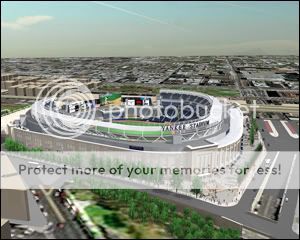The House That Steinbrenner Built
Built in 1923, Yankee Stadium stands as the third oldest ballpark in Major League Baseball. In April 2009, the Yankees will be playing in the newest.
One of baseball’s most historic franchises, the New York Yankees plan to move out of the “House that Ruth Built” to an updated, fan-friendly stadium just across the street from where the current stadium presently sits.
“We developed the new stadium with the needs of the Yankees and the fans in mind,” Yankees principal owner George Steinbrenner said at the ground breaking of the new stadium in August 2006. “This new ‘Home of Champions’ will preserve the architectural integrity of the original Yankee Stadium, while incorporating modern amenities.”
HOK Sports, architect of the new stadium, and the team designed the new stadium to keep as much of the feel of the original stadium as possible, keeping much of what made Yankee Stadium one of the most recognizable in the game. The designers have kept the field dimensions identical, and will bring Monument Park, a staple of Yankee Stadium, and put it in center field. They also will bring back the classic frieze or façade to the new stadium. The façade has been missing since it was removed from the roof of the original Yankee Stadium when it was renovated before the 1976 season.
According to the team’s website, the new Yankee Stadium will seat about 4,000 fewer fans than the previous stadium, or about 50,000, but will now include 60 luxury suites, three of which will be outdoor suites, and eight party suites. New features will be found around the stadium like restaurants, and a larger, more spacious concourse and entertainment area for concessions.
In violation of the Americans with Disabilities Act (ADA) for years, the Yankees took the opportunity to make the new stadium as accessible as possible for everyone. Team officials worked with the United Spinal Association’s Accessibility Services group to create new features to accommodate those in a wheelchair and those with hearing or vision loss. The new stadium will feature more accessible bathrooms and seating as well as scoreboards that transcribe what is said over the public address system.
Yankee Stadium has been a staple of the Bronx for over 84 years, but to stay in the area the team needed to build the new on what little open space is left in the Bronx, Macombs Dam and John Mullaly Park.
The loss of these parks would result in the loss of over 25 acres of open land and has been met with opposition.
“This plan sets a dangerous precedent by taking public parkland for use by a large, private commercial enterprise.” The group Save Our Parks, a neighborhood group that opposed the building of the new stadium, said in an open letter to the Bronx community board in 2005.
To address those concerns, the Yankees, the city and the state of New York have plans to replace the parkland with brand new parks for the community.
“The plan for the new Yankee Stadium will be a boon to Parks,” Parks & Recreation Commissioner Adrian Benepe said in a statement. “We will develop over 28 acres of premier park facilities including over 15 acres of beautiful new Bronx parkland on the Harlem River waterfront and at the current stadium site.”
Included in the plan are three grass baseball fields to be built on the site of the current stadium, a waterfront park that has 16 tennis courts and a rooftop park with a basketball court and artificial turf field. The park redevelopment plan is not scheduled to be completed until the fall of 2011, over two years after the new stadium is set to open.
(The image accompanying this story is from NewYork.Yankees.MLB.com)





